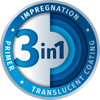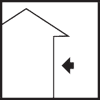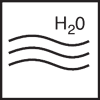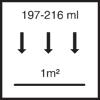Article No. 712001
Water-based, quick-drying premium wood stain for professional use


Hazard warnings
- Use biocides safely. Always read the label and product information before using!
Product specifications
The stated values represent typical product characteristics and are not to be construed as binding product specifications.
Field of application
- For use on exterior wood
- Wood which is not in ground contact, in accordance with DIN EN 335-1, use classes 2 and 3
- Wood building elements with no dimensional stability: e.g. fences, framework, carports, planking
- Wood building elements with limited dimensional stability, e.g. folding shutters, matchboarding, summerhouses
- Dimensionally stable wood building elements (when used as a primer only): e.g. windows and doors
- Primer, intermediate and finishing coats
Properties
- Low-build stain
- 3 in 1: impregnation, primer and stain
- Protects wood from moisture and provides effective protection against blue stain fungi
- Protection against weathering (constructive protection and the protection provided by the product) reduces the risk of blue stain and rot
- Increased solids content provides physical protection against nesting wasps
- Film preserver protects against mould and algae
- Water-based: does not give off any unpleasant odours and tools can be cleaned with water
- Quick drying: 2 coats can be applied in one day
- Subsequent treatment without sanding
- Long-term protection with uniform weathering and no flaking
-
Preparation
-
Substrate requirements
The substrate must be clean, dust-free and dry.
Dimensionally stable wood building elements: wood moisture content 11-15%
Wood building elements with limited or no dimensional stability: wood moisture content max. 18%
-
Preparations
Completely remove old coatings (e.g. paints or medium-build stains), bark, bast and dirt.
Remove loose and torn knots as well as resin that bleeds and clean with a suitable product (e.g. Remmers thinner & brush cleaner).
Smooth, planed wood surfaces should be sanded and dusted before the coating is applied to ensure better absorption.
Observe BFS Code of Practice No. 18 "Coatings on Wood and Wooden Working Materials in Outdoor Areas".
-
-
Application
-
Stir well.
Qualified specialist companies: apply by brush, spraying in closed systems only.
Apply in the direction of the grain.
Apply a second coat once the first has dried.
Use material with the same batch number on contiguous surfaces (mix material of different batches beforehand), otherwise slight differences in colour, gloss and texture may occur.
Seal opened containers well and use contents as soon as possible.
-
Application instructions
-
Check colour, adhesion and compatibility with the substrate by setting up a trial area.
Before coating technically modified woods and wood-based materials, apply the product to a trial surface and conduct a suitability test on the desired area of use.
Do not use at temperatures below +5°C.
If the temperature is too low or the humidity too high, it will take longer for the material to reach the desired properties.
Substances in oak may bleed, causing dark discolouration, when coated with water dilutable dispersion stains.
Pre-testing is recommended also on other woods.
Clear, white and hemlock are suitable for use only on not directly weathered surfaces in outdoor areas, such as roof eaves, or as base coat.
Due to the different covering properties of white and pastel varnish colours, the optical appearance may vary depending on the substrate. It must be checked in advance whether discolouration of the varnish may occur due to substances contained in the wood.
Due to the low UV protection of these colour shades, shorter maintenance intervals must be expected.
In order to take account of and clarify these issues, a trial surface must be prepared in order to ensure that the surface meets expectations.
Rainfall may cause water soluble substances to bleed from wood that is rich in such substances, e.g. oak, red cedar, afzelia, redwood, etc. This may lead to the discolouration of light-coloured masonry or render.
End-grain surfaces must be sealed with the corresponding colour (at least 2 applications)
Cut end-grain surfaces at the bottom to create a water-drip edge.
Each layer of stain results in a more intense colour and a glossier finish.
-
Drying
Practice values at +20 °C and 65% relative humidity.
Low temperatures, poor ventilation and high humidity delay drying.
Use a foamed protection foil between the single coated wood elements to avoid blocking.
-
Working tools / cleaning
-
Acrylic brush, flat brush
-
Clean tools with water or Aqua RK-898 Cleaning Concentrate immediately after use.
Ensure that any residue from cleaning is disposed of correctly.
-
Storage / shelf life
-
Store in well-sealed, original containers, out of the reach of children and in a dry, cool, well-ventilated room which is protected from direct sunlight and frost. No smoking is permitted in storage areas.
-
Usage
-
Preventive protection against blue stain at 197-216 ml/m² in at least 2 applications
-
General information
-
On planed larch and softwoods with a high resin content, the coating may have reduced adhesion and resistance to weathering. This is especially the case on horizontal year rings, knots and areas of winter growth that are high in resin. Maintenance and renovation must be carried out more frequently on these surfaces.
The only remedy for this is pre-weathering or very coarse sanding (P80).
If these wood types are rough-sawn, considerably longer maintenance and renovation intervals are to be expected.According to the current state of the art (this includes DIN 68800-1 and -3 in Germany), wood preservation measures must also be planned for non-load-bearing wooden elements in good time and with due care, with the agreement of all parties involved in the construction (architect, developer, builder) and in compliance with the legal requirements and the conditions on site. The use of biocidal (“chemical”) wood preservatives should therefore always be indicated in suitable fashion prior to sale, or must be agreed in advance with the client in writing. Failure to comply with this requirement may result in country-specific or contract-specific conflicts with legal requirements, standards or certification systems. The Remmers Technical Service would be happy to discuss the matter and provide you with a template agreement for the use of a biocidal (“chemical”) wood preservative on the wooden elements being used.
Observe the regulations concerning design principles for wood protection.
Do not use on horizontal surfaces without drainage slopes and without edge radius, avoid accumulated moisture.
-
-
Disposal instructions
-
Larger quantities of leftover product should be disposed of in the original containers in accordance with the applicable regulations. Completely empty, clean containers should be recycled. Do not dispose of together with household waste. Do not allow to enter the sewage system. Do not empty into drains.
European waste code 03 02 05* other wood preservatives containing hazardous substances
-
-
Safety / regulations
-
For further information on the safety aspects of transporting, storing and handling the product and on disposal and environmental matters, please see the current Safety Data Sheet.
-


















![Aqua OML-48/tm Oil Medium Layer Stain [eco] Aqua OML-48/tm Oil Medium Layer Stain [eco]](https://m.remmers.com/gebindeabbildungen/2400w/51830.png?w=100&version=7)
